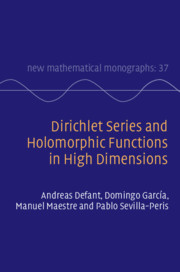Book contents
- Frontmatter
- Contents
- Introduction
- Part 1 Bohr’s Problem and Complex Analysis on Polydiscs
- 1 The Absolute Convergence Problem
- 2 Holomorphic Functions on Polydiscs
- 3 Bohr’s Vision
- 4 Solution to the Problem
- 5 The Fourier Analysis Point of View
- 6 Inequalities I
- 7 Probabilistic Tools I
- 8 Multidimensional Bohr Radii
- 9 Strips under the Microscope
- 10 Monomial Convergence of Holomorphic Functions
- 11 Hardy Spaces of Dirichlet Series
- 12 Bohr’s Problem in Hardy Spaces
- 13 Hardy Spaces and Holomorphy
- Part 2 Advanced Toolbox
- Part 3 Replacing Polydiscs by Other Balls
- Part 4 Vector-Valued Aspects
- References
- Symbol Index
- Subject Index
1 - The Absolute Convergence Problem
from Part 1 - Bohr’s Problem and Complex Analysis on Polydiscs
Published online by Cambridge University Press: 19 July 2019
- Frontmatter
- Contents
- Introduction
- Part 1 Bohr’s Problem and Complex Analysis on Polydiscs
- 1 The Absolute Convergence Problem
- 2 Holomorphic Functions on Polydiscs
- 3 Bohr’s Vision
- 4 Solution to the Problem
- 5 The Fourier Analysis Point of View
- 6 Inequalities I
- 7 Probabilistic Tools I
- 8 Multidimensional Bohr Radii
- 9 Strips under the Microscope
- 10 Monomial Convergence of Holomorphic Functions
- 11 Hardy Spaces of Dirichlet Series
- 12 Bohr’s Problem in Hardy Spaces
- 13 Hardy Spaces and Holomorphy
- Part 2 Advanced Toolbox
- Part 3 Replacing Polydiscs by Other Balls
- Part 4 Vector-Valued Aspects
- References
- Symbol Index
- Subject Index
Summary
We establish the basic notions around Dirichlet series that are going to be used all along the text. A Dirichlet series converges on half-planes, and that there it defines a holomorphic function. For a given Dirichlet series we consider four abscissas definining the maximal half-planes on which it: converges, defines a bounded holomorphic function, converges uniformly or converges absolutely. We formulate the problem of determining the maximal possible distance between these abscissas. The difference between the abscissa of convergence and absolute convergence is at most one, and this is attained. Also, the abscissa of uniform convergence and of boundedness always coincide (this is Bohr theorem). Then Bohr’s problem is established: to determine S, the maximal possible width of the strip of absolute but not uniform convergence of Dirichlet series, and we show that it is at most 1/2. Finally we introduce the Banach space \mathcal{H}_\infty of Dirichlet series that converge and define a bounded holomorphic function on the right half-plane and reformulate Bohr’s problem in terms of this space. This becomes later an important tool.
Keywords
Information
- Type
- Chapter
- Information
- Publisher: Cambridge University PressPrint publication year: 2019
